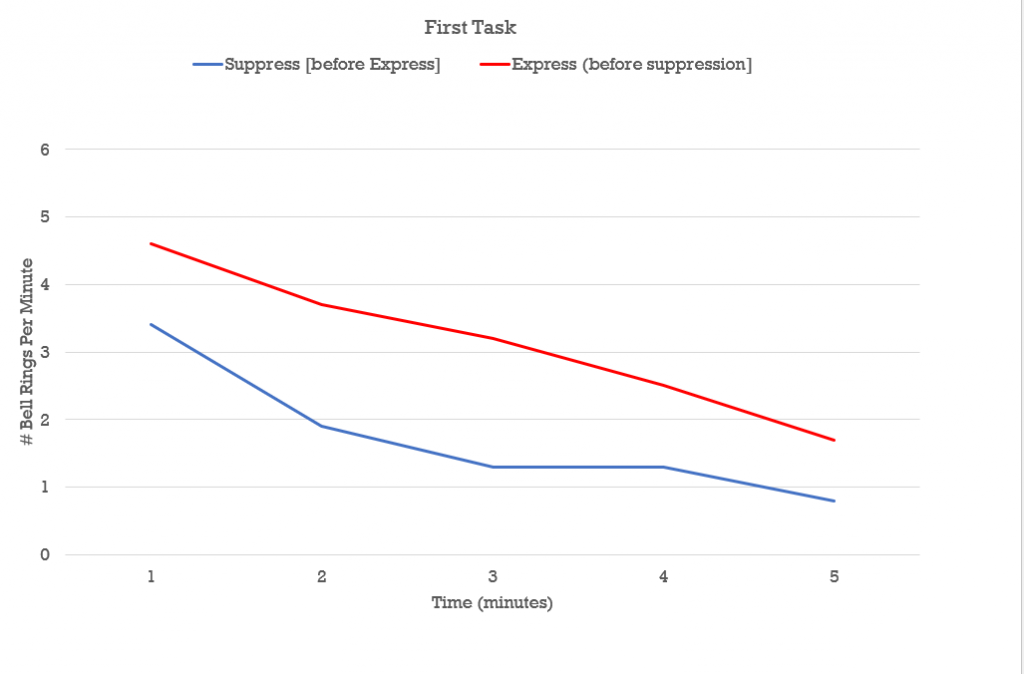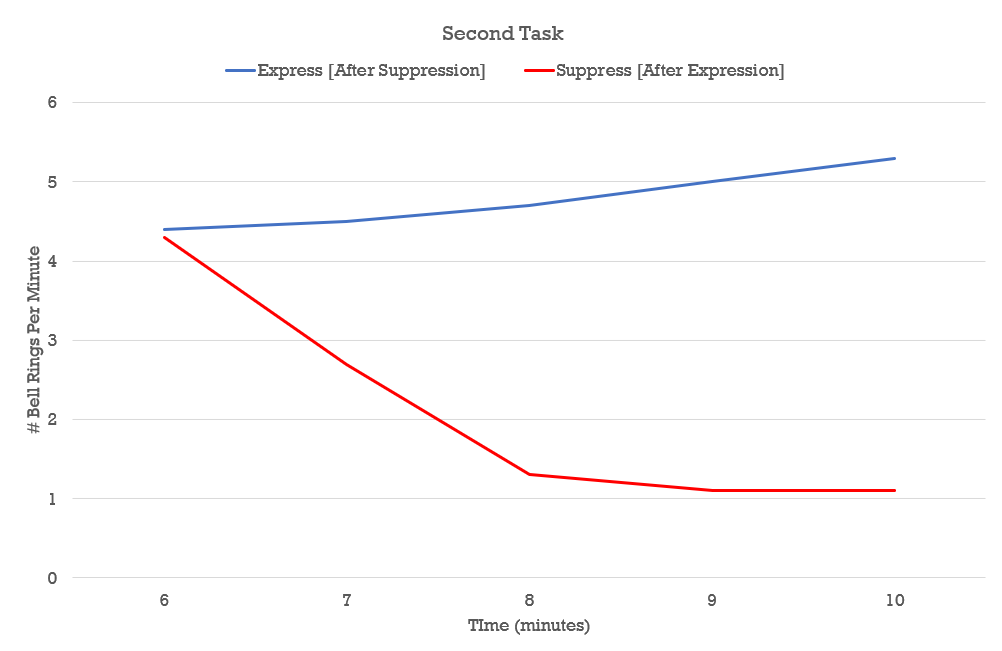Chapter 14 – Emotion Regulation
Response Modulation – Emotional Thought Suppression
Emotional thought suppression occurs when a person tries not to think about thoughts linked to certain emotions. In a classic study by Wegner et al. (1987), researchers tested the effectiveness of thought suppression. All participants were randomly assigned to experience a suppression and expression condition in counterbalanced order. In the suppression part, participants were instructed to not think about a white bear. In the expression part, participants were told to think about white bears. Initial suppression participants completed the suppression followed by the expression condition. Conversely, participants in the expression condition first thought about white bears, then suppressed thoughts about white bear. See Figure 18 below for a depiction of the conditions. During each task, participants were tape recoded while verbalizing their thoughts and instructed to ring a bell each time they thought about white bears.
Figure 18
Depiction of Independent Variable Conditions (Wenger et al., 1987)
| Task | Initial Suppression | Initial Expression |
|---|---|---|
| First Task | Suppress Thoughts of White Bears | Express Thoughts of White Bears |
| Second Task | Express Thoughts of White Bears | Suppress Thoughts of White Bears |
Figures 19a and 19b displays the number of times the bell was rung over time. Figure 19a represents the number of bell rings after participants completed the first regulation task. Figure 19b displays the number of bell rings after participants completed the second regulation task. In Figure 19b, look at the top blue line labeled “express [after suppression].” This group suppressed thoughts of white bears for 5 minutes, and then expressed thoughts of white bears for the remaining 5 minutes. As can be seen in the graph, after suppressing participants had significantly more thoughts of white bears compared to the other three conditions. Wegner labeled this the rebound effect. The rebound effect occurs when after suppressing our thoughts, the number of thoughts we have about the suppressed thoughts drastically increases. Notice that the rebound effect is not found during the suppression, before expression period. The rebound period is another consequence of suppression. Although we can successfully suppress thoughts for a short time period, inevitably this suppression is going to cause an increase in the exact thoughts we didn’t want to have – which might also increase our negative emotions.
Figure 19a
In First Task, Influence of Suppression and Expression on Number of Thoughts Over Time

Long Description
The image is a line graph titled “First Task,” depicting data on bell rings per minute over a five-minute time frame. The y-axis represents the number of bell rings per minute, ranging from 0 to 6. The x-axis represents time in minutes, from 1 to 5. The graph features two lines: a blue line and a red line. The blue line, labeled “Suppress [before Express],” starts at approximately 3 bell rings per minute and displays a downward trend, ending around 1 bell ring per minute. The red line, labeled “Express (before suppression),” starts at about 5 bell rings per minute and also shows a decreasing trend, ending near 2 bell rings per minute. Both lines indicate a gradual decline in bell rings per minute as time progresses.
Figure 19b
In Second Task, Influence of Suppression and Expression on Number of Thoughts Over Time

Long Description
The line graph depicts the results of a “Second Task” by displaying the number of bell rings per minute over time in minutes. The x-axis represents time in minutes, ranging from 6 to 10, while the y-axis represents the number of bell rings per minute, ranging from 0 to 6. Two lines represent different conditions: a blue line labeled “Express [After Suppression]” and a red line labeled “Suppress [After Expression].” The blue line starts just below 4 bell rings per minute at the 6-minute mark and trends upward slightly to just above 4 at the 10-minute mark. The red line starts at nearly 4 bell rings per minute at 6 minutes and decreases sharply, leveling off at about 1 bell ring per minute by 9 minutes, continuing flatly to 10 minutes. The lines are clearly labeled above the graph.
Figure 19
Influence of Suppression and Expression on Number of Thoughts Over Time
Adapted from “Paradoxical Effects of Thought Suppression” by D.M. Wegner, D.J. Schneider, S.R. Carter, and T.L. White, 1987, Journal of Personality and Social Psychology, 53(1), p. 8. Copyright 1987 by the American Psychological Association.
A meta-analysis on 28 thought suppression studies also found that during the initial suppression period thoughts about the target decrease, but then significantly increase after suppression ends (Abramowitz et al., 2001). Interestingly, the rebound effect was not greater for clinical versus nonclinical patients (although only 8 studies included patients recruited from a clinical sample). Some research has suggested that thought suppression may be a symptom of Obsessive Compulsive Disorder (OCD). Research comparing individuals diagnosed with OCD to nonclinical patients found that:
- OCD-diagnosed patients have a tendency to use thoughts suppression more as a coping strategy for unwanted negative thoughts (Amir et al., 1997)
- Show a greater rebound effect (increase in more suppressed thoughts) than nonclinical patients (Tolin et al., 2002b)
- But work out of the same lab found no differences between these two groups in the negative emotions elicited by failing to adequately suppress unwanted negative thoughts (Tolin et al., 2002a)
For an interesting review of the research on thought suppression and OCD, please review this article by Christine Purdon (2004). In this article, Purdon identifies many problems with the research that explain the contradictory findings, one being how the rebound effect is measured (i.e., number of thoughts per 5 minutes, length of one thought per 5 minutes, length of time during expression period).

